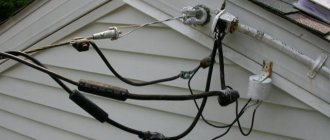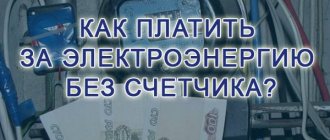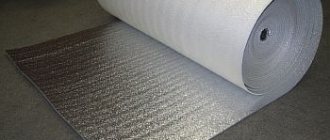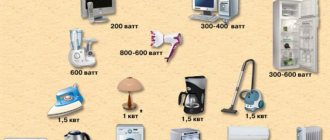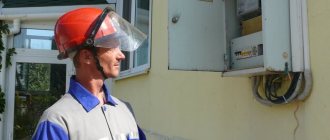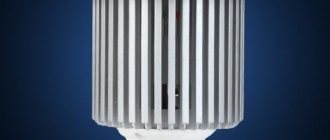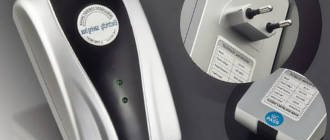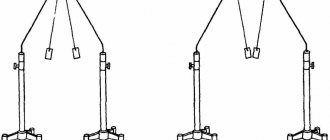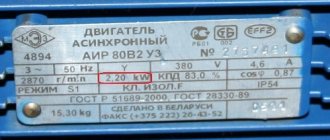Climate control equipment creates a pleasant microclimate in the room. The device operates from the mains, which means that after installing the air conditioner, additional energy costs arise, for which you will have to pay. In order to plan their own budget wisely, many buyers are interested in advance about how much electricity a specific split system model consumes and how these costs can be reduced.
In the article we will look at information about the energy costs of an air conditioner in summer and winter, what energy efficiency classes are, and recommendations for reducing the electricity consumption of an air conditioner.
Air conditioner characteristics
In the technical documentation, manufacturers indicate several power indicators: when operating for cooling, heating and, in fact, electricity consumption. The first two characteristics are not taken into account when calculating how much the air conditioner will consume; on their basis, a suitable unit is selected so that it can cope with maintaining the microclimate in a room of a given area and volume.
The air conditioner consumes approximately 3 times less cooling power. This figure is exactly what is used when calculating energy consumption. On average, it is not 2-3 kilowatts, but only 0.8, which is less than an iron or electric kettle, but more than a computer or plasma TV.
Mobile monoblock air conditioner as an option for heating in winter
What to do if you cannot do without heating with such a device? It is quite appropriate to use a mobile floor unit designed for heating a room. Moreover, it can be placed almost anywhere in the apartment. The monoblock used for cooling uses freon and is equipped with a powerful pump and a long corrugated pipe thrown out the window to remove hot air.
A monoblock heating system can work on the same principle, using in this case not a freon loop system, but a ceramic heater. The biggest stumbling block here is that the outlet hose needs to be routed somewhere. Considering that you have to use such a device in winter, this is not an easy task. Whenever possible, the easiest way is to route the hose into a vent or other similar outlet system.
In any case, this option is quite convenient in winter and heating this way does not cause any special problems. The mobility of the air conditioner allows you to roll it from one room to another, uniformly heating the entire room.
Also interesting: air conditioning modes
What to consider
The climate control system has a heat pump. It pumps warm air from indoors to outdoors. To operate, it needs to use the right amount of electrical energy. Each split system has two indicators: consuming and cooling-heating power.
By looking at the technical data sheet of a particular split system model, you can see the power characteristics indicated by the manufacturer for cooling, heating, and the electricity consumption of the device itself. The first two indicators are not taken into account when calculating the electricity consumption of an air conditioner. Based on their indicators, they choose the appropriate model for a particular room.
Let's look at it in detail:
- consumer power - a value that shows the amount of energy consumed by equipment from the electrical network;
- cooling-heating power is a value indicating the amount of useful work performed.
Both of these indicators are calculated in Watts (W) or kilowatts (kW). The indicators of generated heat or cold are designated in the technical data sheet as COP and EER, respectively. The readings are inversely proportional to each other. The higher the final figure, the lower the electricity consumption, and vice versa.
Energy Efficiency in Cooling Mode (EER)
| Energy class | Index |
| A | 3.20 EER |
| B | 3.20 EER 3.00 |
| C | 3.00 EER 2.80 |
| D | 2.80 EER 2.60 |
| E | 2.60 EER 2.40 |
| F | 2.40 EER 2.20 |
| G | 2.20 EER |
Energy efficiency in heating mode (COP)
| Energy class | Index |
| A | 3.60 COP |
| B | 3.60 COP 3.40 |
| C | 3.40 COP 3.20 |
| D | 3.20 COP 2.80 |
| E | 2.80 COP 2.60 |
| F | 2.60 COP 2.40 |
| G | 2.40 COP |
You need to understand that the indicators indicated by the manufacturer may differ from those that actually exist. Calculations are carried out at the factory with doors and windows closed, in contrast to apartment conditions, which are not entirely ideal.
The positive point in this matter is that any equipment will consume approximately 3 times less electricity than it produces, since electrical consumption is only needed for refrigerant circulation.
Energy efficiency indicators
Most modern split systems combine the functions of cooling and heating air. In each of these modes, the equipment consumes a different amount of energy resources. The exact consumption depends on many factors.
Device energy efficiency factors
The ratio of the power produced by a device to the energy consumed, which is necessary for its generation, is called the energy efficiency coefficient. It is this indicator that expresses the energy efficiency of climate control equipment.
Split systems have two of them:
- Refrigeration coefficient . Allows you to determine the energy consumption required by the device in cooling mode.
- Thermal coefficient . Makes it possible to assess the level of energy consumption when operating for heating.
To calculate the energy efficiency coefficient, you need to know the parameters of consumed and produced power in different modes, indicated in the equipment characteristics.
It is worth considering that the COP (heating power) value usually exceeds the EER (cooling power) value. This is due to the operating characteristics of the compressor. While working, it heats up and transfers heat to the refrigerant circulating in the system. In heating mode, the heat generated by the compressor serves as an additional source of energy
For example, let's take one of the models of split systems from AUX - ASW-H07A4.
Let's calculate its EER using the following formula:
K=Q/N,
Where:
- K is the required value;
- Q – power of the device in cooling mode (amount of generated energy in kW);
- N – power consumption (the amount of energy taken from the network in kW).
We get: K = 2.1 / 0.65 = 3.23
Therefore, the EER of the model taken is 3.23. The higher the final indicator, the more economically the device uses electricity.
The thermal coefficient COP is calculated using a similar formula. These values must be indicated in the technical data sheet of the device. They can also be obtained from the sales consultant at the time of purchase.
The values of the split system power consumption and output declared by the manufacturer, as well as COP and EER, may differ to one degree or another from the real ones. It all depends on the conditions in which the device is operated.
At enterprises where testing and calculations of energy efficiency of equipment are carried out, conditions are close to ideal. In practice, they are not always observed.
Therefore, it is important to take into account some rules for operating air conditioners to prevent excessive consumption of electricity. We'll look at them in more detail a little later.
The parameters of the considered COP and EER coefficients are fundamental when dividing split systems into energy efficiency classes according to the generally accepted scale.
Energy efficiency classes of split systems
The level of efficiency or “anti-efficiency” of split systems, like many other household appliances, is clearly demonstrated by the energy efficiency scale.
The classification of energy efficiency parameters involves marking devices with special symbols - Latin letters from “A” to “G”. According to the requirements of international quality standards, the designation corresponding to the device must be present on the packaging
Since the category of climate control equipment under consideration is characterized by two types of output power, it is also assigned two energy efficiency classes. Of course, this applies only to those devices that are designed for both heating and cooling of rooms.
The most economical group of equipment is considered to be the models marked “A”, the most energy-consuming – “G” . As existing technologies are constantly improving, manufacturers have begun to produce devices whose efficiency exceeds Class A.
In this regard, the scale was expanded, adding the designations “ A+ ”, “ A++ ”, “ A+++ ”. Such models are an order of magnitude more economical, but also much more expensive than others.
Factors of minor importance
In addition to coefficients and energy efficiency classes, there are a number of additional factors that influence how much electricity the split system will consume:
- compressor type;
- thermal power of the device;
- room area;
- difference between internal and external temperatures.
The air conditioner's flow rate is largely determined by the compressor installed in the device. The amount of energy required depends on the frequency of its rotation. Conventional mechanisms operate on a start/stop principle.
When the sensor detects temperature changes above or below specified levels, the electronic unit starts the engine. After reaching the desired temperature values, it turns off again. In standby mode, virtually no electricity is consumed.
Inverter models smoothly maintain the temperature within the specified values. Therefore, they do not need to completely cool the entire air volume the next time they are turned on. They consume almost half as much electricity, last longer, and can operate for heating even in severe frosts.
The scheme according to which inverter split systems operate is considered more efficient and economical. In these models, compressors operate non-stop, smoothly changing rotation speed and, accordingly, power consumption.
The only drawback of equipment with inverter compressors is the high price. However, judging by user reviews, it pays for itself quite quickly.
The larger the area the air conditioner serves, the higher its consumption will be and the greater the thermal power it should have. This parameter is measured in BTU and is designated in numbers - 7, 9, 12, 18, 24, etc.
For average apartments, the first three options are most suitable.
The rest are installed in large houses and administrative buildings:
- “Seven” corresponds to a value of 7000 BTU (1BTU ≈ 0.3 W). That is, its performance is approximately 2100 W. Such a unit can efficiently serve premises with an area of 20-25 m², while consuming about 0.7 kW/h.
- "Nine" has a power of 9000 BTU or 2700 watts. It is designed for objects with an area of 25-30 m² and consumes electricity within 0.8 kW/h.
- “Twelve” with a performance of 12000 BTU or 3600 W is intended for rooms up to 40 m². Its consumption is about 0.95-1 kW/h.
If you do not compare the thermal power of the device with the area of the room and buy an air conditioner with a lower value than is actually necessary, you may encounter unpleasant consequences.
First of all, this is fraught with increased energy consumption and a shortened service life of the device due to excessive loads.
To ensure uninterrupted and safe operation of the air conditioner, you should ensure that there is an outlet with a power coefficient corresponding to its power, check the parameters of the safety plugs in the electrical panel, and make sure that the wiring is in good technical condition
The temperature outside the window, or more precisely, its difference with the temperature in the room served, also affects the amount of energy consumption.
For example, the outdoor thermometers have risen to +40 °C, and the room needs to be cooled to 22 °C. In this case, the air conditioner will consume more energy than if it were 32 °C outside.
How much electricity does an air conditioner consume per hour?
There is a formula for calculation: the rated power of the split system divided by the EER coefficient. All this data is indicated in the instruction manual.
EER indicates how many times a device's power consumption is lower than its performance. The coefficient depends on the energy efficiency class. Most modern systems have class A, which corresponds to EER >3.20.
For example, the cold performance of an air conditioner is 2.5 kW, class A. We calculate its consumption per hour: 2.5 / 3.20 = 0.78 kilowatts.
Roughly speaking, a split system spends three times less than it produces. Therefore, to the question of how much an air conditioner consumes, the answer will be as follows:
- “sevens” – 0.65-0.75 kW/h;
- “nines” - about 0.78-0.88 kW/h;
- “twelve” - 0.96-1 kW/h.
Please note that the system does not operate continuously. When it reaches the desired temperature, it will turn off.
If the model is inverter, when the specified parameters are reached, the compressor will reduce speed to a minimum without turning off. Maintaining the temperature requires less energy than full cooling.
Manufacturers of inverter air conditioners claim that their devices consume 40% less electricity than conventional models. Thus, the inverter “nine” consumes approximately 500 W per hour.
Optimal operating conditions
The air conditioner can be turned on for heating at temperatures above 0 degrees, and preferably above +5 degrees (in winter, spring and autumn) - this is the verdict of experts. It’s best to look at the instructions for a specific device, where the operating range will be indicated. There are models that can operate in an extended range - for example, up to -5 degrees. It is prohibited to use them in frost below this mark.
Some models can be used at fairly low temperatures, but they are rarely found on sale and are more expensive. They work in temperatures as low as -25 degrees, which is important for regions with cold winters.
Features of determining network power
In general, the electrical network is designed so that its operation does not require special knowledge. It is enough to follow some rules, the main one of which is to prevent overload.
Important! Failure to comply with the rules for using the electrical network can lead to failure and even fire
It is important to note that the technical characteristics of the outlet and the household appliance differ from each other:
- In sockets, the maximum permissible alternating current is measured in Amperes: in the old housing stock of Russia it is 6 A, in Europe - 10 or 16 A;
- The power of connected devices is measured in Watts.
Information on an electrical appliance can be marked in different ways. How to calculate the power of electricity?
To calculate, you will need the formula: P = U*I, where:
P - power,
U - voltage in Volts,
I is the current strength in Amperes.
The voltage of a working outlet is 220-230 Volts; the current can be measured with a multimeter.
To determine the current strength in the outlet, you should use a multimeter
Other Important Factors
There are other parameters that affect the waste of electricity when operating a split system.
- Compressor potential (at lower rotation speeds, less energy is consumed). The most profitable are inverter models.
- The actual electricity consumption of the air conditioner will be shown by the temperature difference (outdoors versus indoors). The costs of heating a room in forty-degree frost will be much higher than for cooling a room in the unbearable summer heat.
- Cooling loads in a split system.
- Various additional functions of the device.
How to reduce energy consumption?
The actual electricity consumption when operating a split system can be significantly reduced. To do this, you should take care of the normal operating conditions of the equipment, properly care for it, and promptly prevent malfunctions that affect the power of the device.
Next, we will talk about the nuances and rules that every owner of climate control equipment should know. By following them, you can extend the life of the device, ensure its maximum efficiency and reduce energy costs.
Method #1 - buying economical equipment
If you want to purchase an economical split system model, we recommend that you pay attention to several devices from trusted manufacturers that are characterized by the lowest energy consumption.
Mitsubishi Electric MSZ-LN25VG/MUZ-LN25VG system
The inverter model of the famous Japanese brand consumes only 485 W in cooling mode and 580 W in heating mode.
At the same time, the output power is very high. The device has been assigned the highest energy efficiency class – A+++.
The device attracts with its stylish design, many advanced technologies and advanced functionality. It is equipped with the new safe R32 refrigerant, which gives it increased energy efficiency
Among the useful functions it is worth noting:
- economical night mode;
- 2-stage air filtration/disinfection system;
- wi-fi interface for remote control from a smartphone - allows you to cool/warm the room before household members arrive;
- 3D I-SEE system – scans the room, identifies the location of people, evenly distributes air masses in two directions, eliminating overheating and hypothermia of individual parts of the room; in the absence of people, the sensor automatically activates the energy-saving mode;
- Hybrid coating of the case protects against dirt and dust.
The model is distinguished by its low noise level, maintaining operability down to a temperature of -25 °C. The disadvantage of the product is its high cost - about 74 thousand rubles.
Air conditioner Panasonic CS-E7NKDW
A model from another Japanese brand costs half as much – about 33 thousand rubles. This device also runs on an economical inverter compressor with a continuously variable power control system.
The Panasonic CS-E7NKDW consumes 470 W in cooling mode and 635 W in heating mode. The technical specifications indicate energy efficiency class A+
The list of functional features of the device:
- Autocomfort sensor and Mild Dry – allow you to achieve maximum comfort in the room;
- energy-saving night mode;
- timer for setting on/off;
- automatic restart after power outages;
- Powerful mode – speeds up cooling/heating of the room.
The equipment operates quite silently and copes well with its tasks. The disadvantages are the insufficiently effective air purification system, limited temperature conditions when operating for heating - down to -5 °C.
Split system Ballu BSLI-07HN1/EE/EU
This model of the Chinese brand is one of the most budget-friendly among inverter split systems. It can be purchased at a price of 19 thousand rubles.
A split system from a Chinese manufacturer with class A energy efficiency consumes 650 W in cooling and 590 W in heating mode
Despite the budget price, the equipment is equipped with many useful functions:
- economical night mode;
- timer for setting on/off;
- self-diagnosis of emerging faults;
- preliminary cleaning of air flows;
- operational cooling of the room in turbo mode.
The minimum temperature during heating operation is -10 °C. The disadvantages of the product include noise, an inconvenient remote control, and a not very clear timer setting scheme.
Method #2 - close access to outside air
The first thing you need to do before turning on the air conditioner in order to save energy resources is to tightly close all the vents, windows and doors. If there are gaps in door or window openings that allow air to pass through, they should be eliminated if possible.
Artificial lighting devices in the apartment also serve as an additional source of heat. When using an air conditioner for cooling, it is wiser and more economical to install fluorescent and LED light bulbs in your home. An ordinary incandescent light bulb produces much more heat
On sunny days, it is advisable to lower the blinds and cover the windows with thick curtains or protective reflective film. It is especially important to follow this rule in rooms with windows facing the hot, sunny side.
Such manipulations help minimize the loss of warm or cooled air, which depends on the mode in which the air conditioner operates. As a result, the risk of redirecting most of the air conditioner's power to compensate for heat input from outside is avoided.
A device exposed to direct sunlight draws at least 5% more energy than usual.
Method #3 - choosing the right temperature
Incorrectly selected cooling temperature is the most common mistake among split system users.
The safest and most comfortable temperature range for humans is considered to be between 23-24 °C.
Sudden temperature changes are very dangerous. Frequent transitions from sweltering heat to a cold, air-conditioned room can cause a sharp decrease in immunity and disruption of the human thermoregulatory system. Therefore, when choosing a temperature regime in a split system, it is important to observe the measure
By choosing literally 3-5 values less than the recommended norm, you will jeopardize your health and force the equipment to work at maximum power. Such experiments are fraught not only with colds, but also with increased electricity consumption.
Method #4 - proper care of equipment
The technical condition of the device affects its performance. If the mechanisms are contaminated, the integrity of individual elements is damaged, or there is insufficient amount of refrigerant in the system, the power of the equipment may drop significantly. We reviewed the rules for filling the system with freon here.
The air conditioner will consume energy, but will not be able to cope with its direct responsibilities.
To avoid this, you need to properly care for your climate control equipment:
Image gallery
Photo from
Split system care
Systematic cleaning of filters and protective nets
Refrigerant quantity control
Checking the condition of connecting tubes
As you can see, any split system requires regular maintenance. Otherwise, you may encounter increased energy consumption, serious breakdowns or irreversible failure.
We recommend that you familiarize yourself with the features of self-service of split systems.
Method #5 - ensure proper operation
Each split system is designed to operate in a certain temperature range. This nuance must be clarified before purchasing. You can view the information in the instructions included with the product.
After installing the split system, it is important to ensure free access of air to the indoor and outdoor units. Obstructions reduce equipment efficiency and increase energy consumption
Permissible operating temperatures must not be violated, otherwise the efficiency of the device will drop sharply. If the minimum recommended temperature for using the device in heating mode is -5 °C, then it should not be turned on when it is colder outside.
To heat rooms in cold weather, there are special models of split systems. In such conditions, they will use electricity more efficiently.
Calculation of air conditioner power by room area
When calculating energy consumption, the area, not the volume, of the building being cooled is taken into account. This is due to the fact that cold air still sinks. Whatever the height of the ceilings, the cooled air will still accumulate near the floor of the room.
The following table is good for calculating the power of an air conditioner:
| sq. m | 16 | 20 | 26 | 35 | 37 | 30 | 52 | 70 | 80 |
| thousand BTU | 5 | 7 | 9 | 12 | 13 | 14 | 18 | 24 | 30 |
| kW | 1.6 | 2 | 2.6 | 3.5 | 3.7 | 4 | 5.2 | 7 | 8 |
However, it is necessary to take into account a large number of related factors and coefficients:
- the size of the family or other group of people in the room;
- the amount of heat generated by the people themselves in the room (this depends on the amount and intensity of physical labor, as well as on whether people wear outerwear);
- distance from floor to ceiling;
- the presence of other heat-producing devices and apparatus (TV, computer);
- the amount of heat entering the windows with the light of the sun.
Most online calculators for selecting air conditioner power take these parameters into account.
For example, below are calculations that require knowledge of such parameters as:
- coefficient from 30 to 40 W/cubic. m to take into account the heat generated by the room itself due to the area of the walls, ceiling and floor, as well as depending on the presence of solar radiation;
- the heat generated by the owners of the house is from 0.1 kW to 0.2 kW (for an adult), depending on physical activity.
Let’s try, as an example, to select a cooling unit with the following parameters:
- living area – 25 sq. m;
- ceiling height – 2.55 m;
- family of 3;
- computer and TV in one room;
- The windows face north.
Here are instructions for calculations:
- First, let's calculate the heat release of the room itself using the formula: Area x Height x Internal heat release coefficient of the building. Here's the calculation: 25 x 2.55 x 30 = 1.9 kW.
- Let us further assume that all the inhabitants of the refrigerated space behave calmly and mostly relax at home: 0.1 x 3 = 0.3 kW.
- Now let’s include the heat emission from the computer and TV into the calculations. The PC has a power supply with a nominal power of 0.3 kW, and the TV has a power supply of 0.2 kW. Let's assume that it is quite possible for one of the family members to watch TV and someone else to use the computer: 0.3 + 0.2 = 0.5 kW.
- We add up all the obtained values: 1.9 + 0.3 + 0.5 = 2.7 kW.
Parameters that change the performance of air conditioners
Residential air conditioners interact directly with the environment, which can change performance parameters. The most common factors influencing the cooling force:
- Glazing area. The performance of a split system may vary depending on the intensity of lighting, the direction of the world, and the area of window openings. The greater the influx of sunlight (and heat), the slower it will cool the air.
- Upper floors. The determining criterion here is also the additional influx of thermal energy from the heated roof of the building.
- Supply air. The air entering during ventilation can be very warm. Therefore, manufacturers do not recommend opening windows while the climate control equipment is operating; this can interfere with its program and place additional stress on the system.
- Air temperature. The cooling capacity of a split system is determined by standards. If one of the indicators of these standards increases (for example, the temperature outside has increased), the performance of the equipment may not be sufficient for efficient operation.
How much will summer comfort cost?
If we assume that the start-stop “nine”, which is not particularly economical, will be turned on 8 hours a day, in moderately hot weather, and its power consumption is 0.8 kilowatts, then the daily electricity consumption will be approximately 6.4 kW/hour. Multiplying this number by the average cost of a kilowatt of electricity of 4.32 rubles, we get 28 rubles. In this case, the monthly expense will be 840 rubles (28x30=840).
According to manufacturers, an inverter air conditioner consumes 40% less electricity. This means that it will no longer consume 0.8 kilowatts, but approximately 0.5. At the same time, it will cool in the same way as a start-stop. As for the daily electricity consumption, it will be 17 rubles for 8 hours and 510 rubles per month (17x30=510).
Second way
You can calculate monthly electricity consumption in a more complex way, if you start from hourly power consumption and a certain model of air conditioner operation. Let's assume that electricity consumption follows a typical pattern:
- 2 hours the inverter “nine” works with 100% power;
- 3 hours at 75%;
- 4 hours at 50%;
- 5 hours at 25%.
Then 0.78x2+0.78x3x0.75+0.78x4x0.5+0.78x5x0.25=5.85 kW/h will be consumed per day.
We calculate how much it will be in a month: 5.85 x 4.32 x 30 = 758.16 rubles. The difference with 510 rubles is of course big, but it is worth considering that when calculating with the first method, 8 hours of work were taken, and with the second - 14.
At whose expense can I change the electric meter?
All of the above calculation methods are approximate; it is impossible to accurately predict how much electricity will be consumed. At different times of the day, the air conditioner consumes different amounts of kilowatts, much depends on the weather and operating mode. In any case, we are not talking about astronomical sums, and the cost of summer comfort is quite adequate to the perceived comfort.
Cost of owning an air conditioner and ways to save
So, as we see, owning an air conditioner is not a cheap pleasure, but, in principle, not so expensive, considering what we get in return: coolness and comfort in our rooms during the hot summer months.
In addition, the cost of operating an air conditioner can be optimized in several simple ways:
- You can reduce the costs associated with operating your air conditioner by regularly and thoroughly cleaning the ventilation ducts. In this case, their cross-country ability will be higher, as will the cooling effect, so you will turn on the device less often, which will save on energy bills;
- Another good way to reduce costs is to seal your windows and doors and install blinds that block out strong sunlight. This way, the air-conditioned room will heat up less, which means you will use it less often;
- Another way to save money is to not open windows during the summer season. Unfortunately, many homeowners forget about this, although when the windows are open, the entire cooling efficiency of the rooms is reduced to zero. The rooms can be ventilated in the evening or morning, but during the day (in the heat) it is better not to do this and use only air conditioning;
- Another way to optimize the cost of operating an air conditioner is to slightly increase the temperature in the device’s thermostat. Remember: the lower the temperature on the thermostat, the higher the cost of using the air conditioner;
- If you have several air conditioners in your home, experts advise turning off the fans installed in the rooms while they are running. Thanks to this solution, the air conditioner will cool the rooms more efficiently, and you can save several thousand rubles a year.
Feasibility of the process
Air conditioners with heating function are structurally different from their older counterparts. The devices are equipped with a heat pump, making them very economical: one kilowatt of electricity spent on the air conditioner produces 2.5 to 4.2 kW of heat at the output. The devices are capable of efficiently heating a room at outside temperatures from 0 to -15 degrees, but more powerful units can easily cope with frosts of 30 degrees. For comparison: an oil heater, consuming the same kilowatt of electricity, is capable of delivering only 0.95 kilowatts of heat.
It follows from this that heating costs using an air conditioner are spent two times less than heating a house with a heater. However, it is advisable to choose an air conditioner as a heat source only in non-gasified regions, or in places where expensive liquefied propane is used instead of natural gas. In other cases, heating with air conditioning is certainly more expensive than heating with natural gas, and preference should be given to the latter.
Saving tips
There are several ways to save energy:
- Choose an inverter type of air conditioner or with an inverter compressor.
- Keep an eye on the filters and heat exchanger; if they are dirty, it takes longer for air to enter the room.
- After use, turn it off and unplug it from the socket (since even in this state it consumes electricity).
- If you don't need it, turn it off.
- Do not open windows and doors so that the converted (cooled or heated) air does not escape into the street.
Winter maintenance
How should an inverter air conditioner operating for heating be maintained? Apart from ice removal, maintenance is no different from any other air conditioner.
If you do not want to breed mold and mildew, it is enough to clean its filter once every two weeks and wash the impeller twice a year after disassembling the device. All bacteria and fungi that are dangerous to health also accumulate there.
Other types of work, for example, topping up freon or inspecting the external unit, should be carried out by specialists with the appropriate equipment. You better not go there.
Technical condition of the air conditioner
The efficiency of an air conditioner very much depends on its technical condition and can sometimes drop almost to zero if the air conditioner is dirty or malfunctioning.
Air conditioner dirty
If the filters, fan and heat exchangers of the external and internal units of the split system are dirty, then the efficiency of the air conditioner decreases.
Moreover, if the pollution is very strong, then it is noticeable to the eye - the air conditioner blows “warm air”, and if it is not too strong, then no, but the air conditioner still treacherously increases the electricity meter.
The main recommendation in this case is to clean the filters more often.
Filters must be washed under running, not hot water; if necessary, you can use neutral detergents, such as dishwashing detergent.
The amount of freon in the air conditioner
The cooling efficiency of a room air conditioner also depends on the presence of freon in its refrigeration circuit.
Moreover, its quantity should be optimal for the refrigeration system.
The efficiency of the air conditioner drops both when freon leaks and when it is refilled!
The “bigger is better” principle does not apply to an air conditioner.
And even if the air conditioner cools normally, this does not mean that it is operating in its optimal mode.
The only way out for a non-specialist in this case would be to carry out regular maintenance.
Those who want to learn how to diagnose and repair an air conditioner on their own can study our constantly updated section “Do-it-yourself air conditioner repair”
Thermal insulation of copper tubes
The external and internal blocks of the split system are connected by tubes through which freon circulates; its temperature is much lower than the ambient temperature and therefore losses also occur through them.
And the longer the route, the greater the heat loss.
Thermal insulation on the tubes may not be partially applied during installation; birds love to peck at it, using it to insulate their nests, and it also loses its properties over time.
So you need to monitor the integrity of the thermal insulation and restore it.
Air circulation in the room
Since the air conditioner operates on a principle similar to that of a refrigerator, the constant flow of cold or hot air forces the device to work with increased load. This directly affects electricity consumption – it increases.
How much electricity does an air conditioner consume?
Power consumption shows how much electricity the device consumes per hour
The air conditioner's passport indicates 2 powers: consumed and productive. The first shows how much electricity the device consumes per hour.
The second is the efficiency of using power consumption. It is always more than consumed, since in an air conditioner energy is spent only on the operation of the pump and fans blowing the evaporators.
For heating
To determine energy consumption for heating a room, 2 parameters are used: productive power and efficiency coefficient COP.
To obtain the amount of electricity consumption for 1 hour, you need to divide the productive capacity by the COP.
The coefficient can be found in the device passport or in the table below.
| Energy efficiency factor | Energy efficiency class | ||||||
| A | B | C | D | E | F | G | |
| EER (heating) | 3.2 | 3.1 | 2.9 | 2.7 | 2.5 | 2.3 | 2.1 |
| COP (cooling) | 3.6 | 3.5 | 3.3 | 3.0 | 2.7 | 2.5 | 2.3 |
For example. An air conditioner with energy consumption class A (for this class COP = 3.60), with a productive capacity of 2.2 kW, will consume 0.6 kW of electricity in 1 hour. For 1 month, when operating 8 hours a day, it will consume 144 kW of electricity.
For cooling
When cooling the air, the air conditioning compressor may turn off when the desired temperature is reached
The energy consumption of a split system operating in air cooling mode is calculated using a similar principle, with one difference: instead of COP, the EER coefficient is used.
Unlike operation in heating mode, when cooling the air, the air conditioning compressor can turn off when the desired temperature is reached. This keeps energy consumption to a minimum.
How to save on air conditioner energy consumption
There are several practical tips that will help users save electricity consumption when operating climate control equipment.
Helpful Tips:
- Close doors and windows when operating the air conditioner.
- If the room is sunny, cover the windows with dark curtains or protective reflective films so that the air conditioner does not waste additional energy to compensate for heat gain from the window.
- Choose the optimal cooling temperature and do not constantly switch the temperature setting, forcing the device to work non-stop, consuming additional energy.
- Make sure that the mechanisms in the internal units of split systems are clean and in good working order. Electricity consumption also depends on the technical condition of the equipment.
- Monitor the amount of freon in the split system. If there is a deficiency or excess, the normal operation of the device is disrupted, which can also affect electricity consumption.
- Use the air conditioner only in the temperature range recommended by the manufacturer.
Modern split systems consume a small amount of electricity, and if you follow the operating rules of the device, you can get decent budget savings when paying for electricity.
Consumption calculations
Many people mistakenly believe that an air conditioner consumes a lot of energy, but in comparison with other devices that are plugged in for months, the amount of electricity consumed by climate control equipment turns out to be less. For example, the energy consumption of a household-grade air conditioner for a standard room with an area of 15-20 m2 ranges from 0.3 to 1 kW (minimum and maximum). It should be taken into account that the climate control equipment does not operate constantly, but is turned on only to maintain the temperature in the apartment within certain limits, and if you add up the energy consumption per month, the amount does not come out too large.
There is no universal formula that answers the question with 100% accuracy of how many kilowatts the equipment will consume. And, first of all, because, again, it is impossible to predict the temperature set in the room (at the same time as that outside). We also do not know how often the device is planned to be turned on. However, approximate calculations of how much energy will be spent can be made - for this you need to take the daily rate of expenditure as a sample.
The expected operation time of a conventional split system operating on the start-stop principle can be 6 hours. If the indicated demand is 800 W per hour, then 4.8 kW will be consumed per day. This means that a day of cooling will cost 21 rubles (at a price of 4.32 rubles per kW/h). This means 630 rubles per month, which will need to be added to electricity costs.
These data can increase significantly if the device needs to operate 24 hours a day (for example, if the apartment is located on the sunny side).
What does power consumption depend on?
What generally determines the energy consumption of an air conditioner during use? Several factors are important here:
- compressor potential;
- temperature difference between indoors and outdoors;
- function performed;
- cooling capacity, i.e. cold load.
Although it is worth noting right away that the dependence of air conditioner consumption on these reasons occurs only for inverters. Models operating in start-stop mode (temperature reached → switched off; temperature changed again → switched on) have unchanged electricity consumption values, but require more time to achieve the specified parameters.
Compressor potential
comparison of the operation of an inverter and a start-stop air conditioner
The lower the compressor speed, the lower the energy consumption. Such energy-efficient air conditioners most often have an inverter method of controlling the operation of the compressor, when a saving mode of energy consumption is automatically activated when the set temperature values are reached.
That is why inverters are considered a more profitable purchase compared to conventional start-stop units, which always operate in the same power mode.
We recommend: General ventilation: classification of air exchange methods, principles of supply and exhaust movement
Temperature difference
The greater the temperature difference between the room and the street, the greater the power consumption of the air conditioner in kW. If it's 40°C outside and you want to set your home to 22°C, the costs will be higher than if it's 25°C outside.
For an air conditioner with linear energy conversion, the power consumption per hour itself will not change, but when the set temperature is reached, its compressor will turn off and turn on when it rises.
Different functions performed
Different functions require different time commitments. In principle, there is an analogy here with the previous paragraph. There will be no changes in the power consumption of the air conditioner in kW per hour, but with large time expenditures, the number of kW that the air conditioner “ate” will increase, therefore, the cost of paying for utility bills will be higher.
Working in the cold
How is the relationship between cooling capacity and how much power is consumed by the air conditioner from the network? In fact, the relationship is simple - the higher the cold load, the higher the electricity consumption.
Is it expensive to maintain an air conditioner?
The cost of operating an air conditioner in a detached house consists of several factors:
- electricity consumption;
- filter replacement;
- the cost of periodic inspection and cleaning of the entire installation.
The main point to start with is calculating the energy consumption of the air conditioner, because the cost of electricity will be the most significant expense for the homeowner.
Electricity costs
Electricity costs depend on the power consumption of the air conditioner. Let's take, for example, the power of a standard air conditioner, which consumes 2.5 kW/h when turned on (this type of device is used in rooms up to 25 sq. m.). This air conditioner model, operating 6 hours a day, will consume 15 kW of electricity.
How much will this cost the home owner? In the Moscow region, the cost of a kilowatt hour from 2022 on a single-phase tariff is 5.56 rubles per 1 kW/h, on a two-phase tariff - 6.39 rubles per 1 kW/h during the day, and 2.41 kW/h at night. We don’t know what tariff will be used, but it is obvious that no one will use the air conditioner at night, so for ease of calculations, we will round these data closer to the upper limit and take the cost of electricity as 6 rubles per 1 kW/h.
It is easy to calculate that if you use the air conditioner only in the summer months (from June to August inclusive), turning it on for an average of 6 hours every day, the homeowner's expenses will be:
(2.5 kW/h x 6) x 6 rubles per 1 kW/h x 90 = 8100 rubles
The amount is not small, but still such a case will be typical only for a very hot summer, when every day will be clear and sunny.
Still, in the Moscow region, summer is mostly cloudy, so let's see what happens if the air conditioner turns on not every summer day, but every other day:
(2.5 kW/h x 6) x 6 rubles per 1 kW/h x 45 = 4050 rubles
Let’s say there will be not one, but three air conditioners in the house (for example, one for the living room, and one for each of the 2 bedrooms). Moreover, for the hall there will be the same air conditioner as in the examples above, and for the bedrooms - less power, consuming 1.5 kW per hour:
(2.5 kW/h x 6) + (1.5 kW/h x 6) + (1.5 kW/h x 6) x 6 rubles per 1 kW/h x 45 = 8910 rubles
That is, all electricity costs will amount to 10 thousand rubles per season. Considering that in this case several rooms of the house will be cooled at once every second summer day for 6 hours, the amount, in general, looks acceptable.
Of course, all the calculations given are approximate. In practice, these figures can vary greatly, both positive and negative, depending on the intensity of use of the air conditioner, temperature, number of sunny days, etc. Many homeowners use air conditioners not only in the summer months, but already from April-May and ending in September-October.
Another important factor is also the electricity tariff you choose and the presence of intermediaries in the chain (if you are not directly connected) or, conversely, discounts from suppliers. Although, as practice shows, a simple single-phase tariff remains the most profitable for the operation of an air conditioner (because rarely anyone uses it at night).
Costs associated with cleaning and maintaining the air conditioner
When installing a home air conditioner, you should also consider the cost of having it professionally serviced. It will be better if this is done by a qualified company that knows all the features of the installed equipment plus will provide a guarantee on spare parts and labor.
What is included in the maintenance of such devices:
- Professional diagnosis of problems;
- Cleaning the air conditioner from dust, plaque, mold and other contaminants;
- Refilling with freon and replacing filters;
- Repair and restoration of damaged / burnt out parts;
- Checking and cleaning of all blocks and drainage systems, coarse and fine filters;
- Antibacterial treatment and prevention
Cleaning and maintenance of the air conditioner should be carried out regularly: preferably at least once every 1-2 years. As a rule, homeowners order this service before the start of the summer season. The cost of such work largely depends on the specifics of the device’s operation, but on average it ranges from 2 to 4 thousand rubles per device.
Features of operation in winter
In winter, the air conditioner defrosts at certain intervals. This usually happens once every 40-60 minutes.
When working for a long time at subzero temperatures, its radiator freezes over, efficiency drops, and the system begins to deal with it on its own.
Many people mistakenly believe that the external unit in this case is heated by some kind of built-in heating elements. This is wrong.
It simply switches the direction of its work. That is, hot freon from the indoor unit begins to flow into the outdoor unit. And it thaws within a few minutes.
The duration and frequency of defrost cycles depends on the degree of icing and is controlled by sensors. Although in inexpensive options this happens simply according to the programmed time.
Air conditioner energy efficiency classes
The energy efficiency class of the air conditioner is indicated in the technical data sheet by the value COP - heating mode and EER - cooling.
Energy efficiency classes of split systems:
- A – COP – 3.60, EER – 3.20.
- B – COP – 3.40/3.60, EER – 3.20/3.00.
- C – COP 3.20/3.40, EER 2.80/3.00.
- D – COP 2.80/3.20, EER 2.60/2.80.
- E – COP 2.60/2.80, EER 2.40/2.60.
- F – COP 2.40/2.60, EER 2.20/2.40.
- G – COP 2.40, EER 2.20.
Which energy efficiency class is better?
Air conditioners of classes A, A+, A++, A+++ are considered energy efficient, the coefficient of which is equal to or higher than 3.2.
As a rule, the higher the class, the more rational the energy consumption. Such devices are more expensive, but they are more economical to operate.
Precision air conditioners: types, installation, maintenance
Preparing a household air conditioner for winter
In the vast majority of cases, a household air conditioner is not used in winter, so for this period it should be put into conservation mode. Some companies even offer this service to their clients.
The repairman who arrives upon request will do the following:
- pumps all the refrigerant into the outdoor unit;
- de-energizes the device (so that the user cannot turn it on due to forgetfulness);
- will install a protective canopy over the outdoor unit, if this has not been done before, which will absorb the blows from falling icicles and snow.
Please note that contacting the service department is mandatory only for owners of some models of powerful industrial air conditioners: without proper preservation, such units are excluded from warranty service. As for household air conditioners, any user can easily cope with preparing the device for winter on their own. The only operation inaccessible to him is pumping the refrigerant into the outdoor unit (special equipment is required), but it is not at all mandatory.
To ensure your air conditioner survives the winter well, do the following:
- Start the device in fan mode and let it run like that for an hour.
- Turn on the heating mode and leave the air conditioner running for another hour. Operating in fan and heating mode will dry the inside of the device well.
- After turning off the device, wipe its external surfaces with a damp cloth.
- Rinse the mechanical air purification filters in soapy water and dry them.
- Disconnect the air conditioner from the power supply.
- Remove the batteries from the remote control.
It is advisable to wrap the outdoor unit with polyethylene. This measure will not only ensure its safety, but will also prevent cold air from blowing into the room through the drainage system.
If you don’t want to or can’t wrap the block for the winter, do the following:
- remove the front panel from the indoor unit;
- dismantle the condensate collection pan by unscrewing the screws holding it (this element is located under the evaporator);
- Plug the opened drainage hole with a tightly rolled rag or napkin.
You also need to make sure that cold air is not blowing into the hole in the wall through which the air conditioner communications are passed. If a draft is still observed in this place, the cracks must be filled with polyurethane foam.
If you use a window air conditioner, you can wrap the outside of it with some kind of insulation. Otherwise, a significant amount of heat will escape through the body of the device to the street. Often such air conditioners are removed altogether for the winter.
Owners of mobile air conditioners that are located entirely in the room only need to cover with some material the hole in the wall through which the heated air is discharged.
Nominal and optimal power of the air conditioner
The rated power refers to the average performance of the air conditioner when operating in cold conditions. But in each individual case it is necessary to calculate the optimal power, which ideally should coincide as much as possible with the first.
Nominal values are selected by manufacturers for each type of cooling device:
- Window units usually have the following standard positions: 5, 7, 9, 12, 18, 24;
- Wall splits correspond to the following model range: 7, 9, 12, 18, 24. Sometimes some brands produce non-standard models with the following nominal values: 8, 10, 13, 28, 30;
- The cassettes go in this order: 18, 24, 28, 36, 48, 60. Non-standard row: 34, 43, 50, 54;
- Channel splits begin the power range with model 12 and sometimes end with 200;
- Console installations have the following variety: 18, 24, 28, 36, 48, 60. In a non-standard version: 28, 34, 43, 50, 54;
- Columns start at 30 and go up to 100 or more.
This list is not accidental. This has already taken into account the selection of an air conditioner and its power based on the area of the room, the height of the ceilings, and the heat flow from household equipment, electric lighting, people, roof and walls, open windows and ventilation.
Is it possible to use the air conditioner in heating mode in winter at very low temperatures?
It is best to use an air conditioner for heating in the cool summer months and during the off-season, i.e. before the start of the heating season and immediately after it. As a rule, the instructions for a household air conditioner indicate the range of outdoor temperatures at which it can operate.
The climatic conditions of most of our country do not allow the owners of the device to fully use the air conditioner in winter due to the possibility of its breakdown.
According to the recommendations of most manufacturers, the optimal use of an air conditioner in winter is its preservation, because at very low temperatures serious problems with the operation of the air conditioner can occur. The lower the temperature, the worse the performance of the air conditioner and its systems:
- the heat exchanger becomes covered with frost and loses power;
- the system constantly turns on, which maintains defrosting of the outdoor unit, leading to the formation of ice build-up inside the compressor and destruction of the fan blades;
- the refrigerant, which did not have time to evaporate in a poorly functioning heat exchanger, flows through the drainage systems into the compressor, causing water hammer;
- The compressor first overheats and then freezes, failing.
Calculation taking into account additional parameters
The usual calculation of air conditioner power, which is described above, most often gives fairly accurate results, but it would be useful to know about some additional parameters that are sometimes not taken into account, but have a strong influence on the required power of the device. The required air conditioner power increases with each of the following factors:
- An influx of fresh air from a slightly open window. The way we calculated the power of the air conditioner assumes that the air conditioner will operate with the windows closed and no fresh air will enter the room. Most often, the operating instructions say that the air conditioner must operate with the windows closed, otherwise an additional heat load will be created when outside air enters the room.
When the window is open, the situation is different; the volume of air entering through it is not standardized and therefore the additional heat load will be unknown. You can try to solve this problem using this method - set the window to winter ventilation mode (open the window slightly) and close the door. In this way, drafts will be eliminated in the room, but at the same time a small amount of fresh air will fall into the room.
It is worth noting that the instructions do not provide for operating the air conditioner with the window slightly open, therefore normal operation of the device cannot be guaranteed in such a situation. If you do use the air conditioner in this mode, then it is worth considering that in this case, electricity consumption will increase by 10-15%.
- Guaranteed 18-20 °C. Most buyers wonder: is air conditioning dangerous to health? The instructions clearly state that the temperature difference between inside and outside should not be very large. For example, if the temperature outside is 35-40 °C, then it is preferable to maintain the temperature in the room at least 25-27 °C. Based on this, in order for the room to have the minimum possible temperature of 18°C, it is necessary that the outside air have a temperature of no more than 28.5°C.
- Top floor. In the case when the apartment is on the top floor and there is no technical floor or attic above it, then the heated roof will transfer heat inside the room. A dark-colored horizontal roof receives many times more heat than light-colored walls. Based on this, heat inflows from the ceiling will be higher than will be taken into account in the usual calculation, therefore power consumption will need to be increased by about 12-20%.
- Increased glass area. During normal calculations, it is assumed that the room has one standard window (with a glazing area of 1.5-2.0 m2). Based on the degree of sunlight, the power of the air conditioner changes by 15% more or less from the average. In the case where the glazing size is larger than the standard value, then the power of the device should be increased.
Since conventional calculations take into account the standard glazing area (2*2), then in order to compensate for additional heat inflows for each square meter of glazing over 2 sq m, you should add 200-300 W in strong lighting, 100-200 W in average insolation value and 50-100 W for shaded rooms.
So, if the room:
- located on the sunny side;
- the room has a large amount of office equipment;
- there are a large number of people in it;
- it has panoramic windows,
then they add an additional 20% of the required power.
In the case when, taking into account additional parameters, the calculated power has increased, it is recommended to choose an inverter air conditioner. Such a unit has variable cooling capacity and therefore, if installed, it will cope more efficiently with a wide range of heat loads.
Consultants at santehnikportal.ru do not recommend choosing a conventional air conditioner with increased power, since in a small room it can create uncomfortable conditions due to the specifics of its work.
Thus, calculating the power of an air conditioner allows you to select a device with optimal cooling capacity to create a comfortable microclimate in the room. The larger the area of the room, the greater the power of the device should be. But the greater its performance, the more electricity the device consumes. Therefore, select equipment with the power necessary and sufficient for effective work.
The difference between the operation of an inverter air conditioner
What is an inverter air conditioner and how does it differ from a simple one? The traditional device works according to a simple scheme: it heats the air to a certain temperature and immediately turns off the compressor. The so-called ON-OFF system.
That is, the compressor either works or doesn’t work at certain periods of time. But in inverter models it is possible not to completely turn off the compressor, but to reduce its rated power.
Why does this happen? Due to double conversion of electric current.
Initially, the standard alternating voltage from a 220V outlet is converted to direct voltage. And only then, with the help of an inverter, the direct current is again converted into alternating current, but not with the usual frequency of 50 Hz, but with an arbitrary one.
By adjusting and changing this very frequency, you can regulate the speed of the compressor rotor, and therefore change the power during operation.
You may ask, why all these troubles with frequency and power, and what exactly do they give? And they provide several advantages:
- absence of large starting currents when turned on
- less equipment wear
- but most importantly, a lower permissible operating temperature
That is, inverter models are able to start and operate at outside temperatures of -15C and below (-25C and even -30C). The oil in the system does not stagnate, but circulates constantly.
Most inexpensive household inverters certainly do not reach such low temperatures and operate normally between -5C and -7C.
If you installed such a household model at home, and the frost outside hit -25C, is it possible to turn it on or not? There are several options here.
Firstly, it may simply not start and go into defense. But if it does start working, its efficiency will drop significantly, as will the temperature in your house.
If such a low temperature remains for several days in a row, the oil in the device will thicken.
In this case, it is not recommended to turn off the air conditioner, otherwise a subsequent cold start will kill its compressor.
During operation, for better heating of the room, all inverter models must be able to direct the air flow vertically downwards. In this case, the room will warm up much faster. There is no particular point in heating the ceiling with warm air.
Because of this feature, some advise placing the indoor unit as low as possible, at a level of 0.5 m from the floor. True, in summer such cold for the feet will be very unpleasant.
So look for a compromise.
Operating modes
The electricity consumption of an air conditioner is related to how it works, so let's look at this issue first. Temperature conversion occurs thanks to a heat pump, and it, in turn, works by pumping coolant with a compressor and changing pressure in the lines. The coolant (freon) changes from liquid to gaseous state in the indoor or outdoor unit, depending on how it operates: in cooling or heating mode.
After reaching the set temperature (it is set by the user from the control panel), the system goes into standby mode. When the ambient temperature goes beyond the set limits, it goes into operation mode again. This reduces energy consumption.
It follows: the split system does not operate constantly, but periodically. In standby mode, it consumes virtually no electricity. The current consumed in this state is necessary for the operation of the control system. The compressor consumes the most current, followed by fans.
Features of electricity consumption by air conditioner
Factors that can affect energy consumption when operating an air conditioner are as follows:
- The air conditioner consumes more energy when additional modes are turned on, for example, ionization and air humidification;
- Energy consumption is also affected by the capabilities of the compressor. Inverter type air conditioners are recognized as the most economical type of equipment.
Conventional split systems, which automatically turn off when a set temperature is reached, do not consume energy when they are in standby mode. But as soon as the air temperature in the room deviates from the set parameters, the air conditioner begins to operate at full power, and in this mode the compressor consumes a large amount of current.
The washing machine is electrocuted: why and what to do
